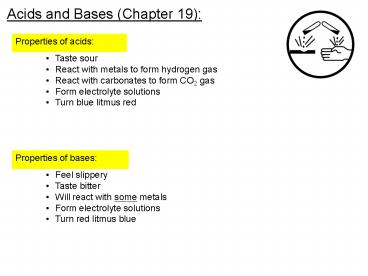Acids and Bases (Chapter 19): - PowerPoint PPT Presentation
1 / 12
Title:
Acids and Bases (Chapter 19):
Description:
Acids and Bases (Chapter 19): Properties of acids: Taste sour React with metals to form hydrogen gas React with carbonates to form CO2 gas Form electrolyte solutions – PowerPoint PPT presentation
Number of Views:48
Avg rating:3.0/5.0
Title: Acids and Bases (Chapter 19):
1
Acids and Bases (Chapter 19)
Properties of acids
- Taste sour
- React with metals to form hydrogen gas
- React with carbonates to form CO2 gas
- Form electrolyte solutions
- Turn blue litmus red
Properties of bases
- Feel slippery
- Taste bitter
- Will react with some metals
- Form electrolyte solutions
- Turn red litmus blue
2
pH scale
H gt OH-
H lt OH-
H OH-
Calculating pH
pH -logH
pOH -logOH-
pH pOH 14
Ex 1 What is the pH of a 0.15 M solution of HCl?
pH -log(0.15)
0.82
Ex 2 What is the pH of a 0.15M solution of NaOH?
pOH -log(0.15) 0.82
pH 14 0.82 13.18
3
Arrhenius model of acids and bases
An acid contains acidic protons that will ionize
in water to form hydrogen ions.
pH of 0.1M soln?
HCl (aq) ? H (aq) Cl- (aq)
pH -log(0.1) 1
pH -log(0.2) 0.7
A base contains hydroxide ions that will ionize
in water and produce aqueous hydroxide ions.
pH of 0.1M soln?
NaOH (s) ? Na (aq) OH- (aq)
pH 14 - pOH
pH 14 log(0.1) 13
Mg(OH)2 (s) ? Mg2 (aq) 2 OH- (aq)
pH 14 log(0.2) 13.3
4
Brønsted-Lowry model of acids and bases
- Acids increase the hydrogen ion concentration in
a solution by donating a hydrogen ion. - Bases increase the hydroxide ion concentration in
a solution by accepting a hydrogen-ion.
HX (aq) H2O (l) ? H3O (aq) X-
(aq)
Acid H donor
Conjugate base
H acceptor
Conjugate acid
Base H acceptor
H donor
5
Another example
NH3 (aq) H2O (l) ? NH4 (aq) OH-
(aq)
acid
base
Conjugate acid
Conjugate base
6
Naming Acids
Binary acids contain hydrogen and one other
element
- First part of name is hydro-
- Second part is the root of the second element
with the suffix ic - Ex HCl is hydrochloric acid
Oxyacids acid form of a polyatomic anion that
contains oxygen
Format Root of anion suffix acid
HNO3
HNO2
Nitric acid
Nitrous acid
7
Acid name
Acid examples
HC2H3O2 HNO3 H2CO3 HCl H3PO4 H2SO4 H2S
Acetic acid (vinegar)
Nitric acid (acid rain)
Carbonic acid (in sodas)
Hydrochloric acid (stomach acid)
Phosphoric acid (in colas)
Sulfuric acid (battery acid)
Hydrosulfuric acid (rotten egg smelling toxin)
The hydrogens that appear first in the formula
are called ACIDIC PROTONS, or just PROTONS for
short.
Monoprotic acid an acid with only one acidic
proton Polyprotic acid an acid with more than
one acidic proton (diprotic 2, triprotic 3)
8
Ionization of polyprotic acids proceeds stepwise
First ionization H3PO4 (aq) ? H2PO4- (aq) H
(aq)
Second ionization H2PO4- (aq) ? HPO4-2 (aq)
H (aq)
Third ionization HPO4-2 (aq) ? PO4-3 (aq) H
(aq)
Anhydrides oxides that can act like acids or
bases in water by reacting with the water.
CaO (s) H2O (l) ? Ca2 (aq) 2OH- (aq)
CO2 (g) H2O (l) ? H2CO3 (aq) ? H (aq) HCO3-
(aq)
9
Indicators organic dyes whose color depends upon
the pH of the solution.
10
Acid-Base reactions
The H from the acid reacts with the OH-1 from
the base to form water.
11
Examples
What would the products be if HCl and NaOH
reacted?
H2O
NaCl
If HCl and KOH reacted?
H2O
KCl
If HCl and Mg(OH)2 reacted?
H2O
MgCl2
2
2
12
In general...
A salt is any ionic compound that is NOT an acid
or a base.































